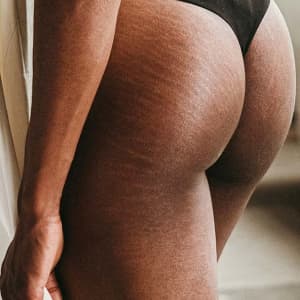 Butt Lift
Butt LiftExpectation vs. Reality: Recovering From A Brazilian Butt Lift
It’s notoriously one of the most difficult procedures to recover from, and we’re breaking down the truth of post-BBL life.
We know, the Brazilian butt lift (BBL) is a highly sought-after surgical procedure that everyone seems to be talking about these days. Those who have spent any time online lately have likely seen documentation of the efforts of many to return home post-op (be it by flight or car). What makes the journey so notorious (and social media-worthy) is the precarious sitting positions required to travel safely without causing damage to the treated areas. However, post-BBL, it appears that all areas are, shall we say, sensitive. And comfort and some semblance of normality are days, if not weeks or months, away.
If you’re considering a BBL, there is a lot of research to be done. We’ve already covered the importance of finding a reputable and qualified provider to give you those hourglass curves. And, now, it’s time to discuss the realities of the BBL recovery process and what to expect once you’ve been nipped and tucked. Spoiler: there’s a lot.
The First Few Days After a BBL
In some ways, the beginning stages of the BBL recovery mirrors other cosmetic surgeries. “Like any surgery, the first week usually entails the most intense pain, swelling, decreased mobility, and some degree of bruising,” explains Ryan Stanton, MD, a board certified plastic and reconstructive surgeon in Beverly Hills. Additionally, he notes that, despite minimal incisions (fat is harvested via liposuction from a donor site and then injected into the buttocks), recovery entails a bit of cleanup. “Often, there is also fluid leakage from the areas of the very small liposuction cannula incisions,” he shares. “This is very normal for the first 12 to 24 hours.”
What makes BBL recovery unique is not just the lack of mobility or the discomfort, but rather the cocktail of considerations. “Patients are expected to change dressings as needed, take prescription pain medication as ordered, and wear provided compression garments,” says Kurtis Martin, MD, a board certified plastic and reconstructive surgeon in Cincinnati, Ohio. Your surgeon and/or surgical team will likely check in before then, but “patients should have their first follow-up visit one week following their procedure,” he adds.
While the exact recovery protocol will depend on your surgeon, here are a few things to keep in mind about the healing process:
1. Sitting & Standing
You probably already know this, but “sitting or laying on the buttock is prohibited for anywhere from two to 12 weeks,” Dr. Stanton shares. Most commonly, the restrictions will last three to six weeks, but clearance will vary by surgeon and patient.
You may not be able to sit on your butt for any real length of time, but that doesn’t mean you can or should be totally comatose. In fact, Dr. Stanton recommends mindful movement. “Standing and walking within the home is actually encouraged to help fluid and blood circulation and thus minimize the risk of blood clots,” he explains. Dr. Martin also suggests light physical activity – such as standing up or taking short walks within a secure space.
What can’t be on the agenda? Squatting, exercise, sex, and strenuous activities that raise blood pressure. Sitting will also be monitored and limited to under 10 minutes in the first few weeks. In the month following, you can usually bump up to 15-minute intervals. Alternate sitting, standing, and walking with laying face down to prevent blood clots and maintain strength.
2. Pain Management
For pain management, providers usually prescribe specific medication, however, that is not the only factor to consider as it relates to physical discomfort. “I think most surgeons would agree that a caregiver is necessary for the first 48 hours postoperatively or, at the very least, the first night while the patient is still recovering from anesthesia and may be unstable on their feet/ambulating,” Dr. Stanton says.
We often note that a caregiver is necessary for leaving the OR after anesthesia, but, once you’ve made it to the comfort of your bed, an aide will prove vital. From providing the medication to helping with bandages, a companion (be it a partner, friend, or professional) can ease stress and give the patient that much less to worry about.
3. Hygiene
While bandaged up, limited in movement, and feeling sore from head to toe, showers and bathroom visits will be difficult. To prepare for this, Dr. Martin recommends over-the-counter stool softeners, staying hydrated, and eating a balanced diet with fiber and protein to keep you regular and avoid strain on your digestive system. When you can safely bathe again will be indicated by your surgeon.
4. Compression Garments
Compression garments are common in body contouring procedures, and BBL is no exception. “Our patients are provided with a special garment that provides compression in the liposuction areas while allowing for the buttock to be open without pressure,” Dr. Martin says. The goal is to improve swelling, reduce movement of the skin in the area, and promote better healing. “This garment is to be worn for several weeks following the surgery,” he adds. For the first 14 to 21 days, you’ll be wearing it most of the day. After three weeks, wear-time is often reduced to 12 hours per day. In terms of fit, the garment should be snug but not so tight that it feels obstructive.
When it comes to clothing over compression garments, Dr. Martin says sartorial choices should revolve around comfort. “Loose-fitting, zip-up clothes” and “lots of extra gauze and chux pads to sop up the liposuction fluid drainage” are doctor's orders.
5. Sleeping
Experts can’t stress enough the importance of adequate rest as you recover. While you will no doubt be tired, falling and staying asleep may prove difficult with the physical limitations. Sitting or sleeping on the gluteal area can create asymmetrical results, which is why pressure should be avoided at all costs. Therefore, sleeping on the stomach and using specialty pillows to keep yourself in place is recommended for best results. Speaking of pillows, you’ll also want to invest in a custom cushion for any sanctioned sitting.
The First Few Months After a BBL
It should come as no surprise that, according to Dr. Martin, “the most challenging aspect for most patients post-op BBL is that you cannot put any pressure on the buttocks for three weeks.” This will impact every aspect of life and should be properly prepared for (more on that below). As we mentioned, sitting is permitted in short intervals. Each provider will have specific guidelines to follow regarding the time you’re allotted. As you heal, you will be allowed to sit for longer periods, but Dr. Martin recommends “laying on your stomach in the back seat of the car, avoiding sitting, or using a special pillow to sit.”
If the recovery process has one feeling anxious, restless, and/or in need of some relaxation, there is good news. “Therapeutic lymphatic massage can be an option for patients to expedite the healing process,” Dr. Martin says. The caveat: “It is not recommended until weeks after the procedure,” he cautions.
For many, resuming normal activities is possible within a month or two of the surgery – with proper precautions. Dr. Martin suggests patients “take it slow and listen to their body.” And please don’t think you know better than your surgeon. “Restrictions are in place for proper healing,” he says. “Follow provided instructions, and do not hesitate to reach out to your provider with any questions.”
BBL Recovery Toolkit
Apart from the postoperative painkillers your provider will prescribe and the adult diapers you may potentially need in those first few days, here are the other tools that will allow for a comfortable recovery in the days, weeks, and months to come:
Sleeping Pillow
BBL recovery is all about keeping your backside as unencumbered as possible and relieving pressure from the glutes. This does create a conundrum while sleeping. To avoid asymmetries and inconsistencies with your results, providers recommend sleeping on your stomach. Depending on your preferred sleeping position, this may be possible with regular pillows, but, for many, additional assistance is needed to get comfortable. A specialty pillow (like this adjustable set) will provide not just relief but the peace of mind that you will not be shifting throughout the night.
Sitting Pillow
We know what you’re thinking, if you’re not allowed to stand for prolonged periods of time or sit on your bottom while recovering, what are you supposed to do? Some form of sitting is possible with the aid of a customized cushion that is specifically designed to alleviate pressure while you return to a semblance of regular activities such as work, commuting, or eating. There are an array of options on the market, and the YesIndeed BBL Pillow + Back Support can be placed in the car or on your chair for maximum comfort.
Compression Garments
For the first few months post-BBL, you’ll likely have to wear a compression garment. While some providers offer them for the initial recovery stage, it’s important to have a fresh set or two to switch to as your results evolve. As this procedure has risen in popularity, the market for post-op shapewear has grown exponentially. This Fajas D Prada design can be a great choice to complement curves while healing.
Personal Care Essentials
When nature calls, there’s only one way to answer. Squatting and/or sitting on your derriere is not an option for a multitude of reasons with this procedure. A toilet seat cushion (yep, there is a solution for everything these days) will allow you to go without compromising your results.
Final BBL Results
Immediately post-op, the body is swollen and the area where the fat was transferred is likely a bit larger than expected. But it’s for good reason: The body naturally reabsorbs some of the fat. Within the first few months post-BBL, the area will slim down some 30 to 50 percent (or more) as the fat establishes itself. This is a natural and expected process that shouldn’t be alarming. If the patient follows their provider’s instructions, is diligent with compression garments, and focuses on positive lifestyle choices, the results should be visible within six months (full healing can take up to a year) and regular physical activity can be resumed.
All products featured are independently selected by our editors, however, AEDIT may receive a commission on items purchased through our links.
More Related Articles
Related Procedures

AI Plastic Surgeon™
powered by'Try on' aesthetic procedures and instantly visualize possible results with The AI Plastic Surgeon, our patented 3D aesthetic simulator.


